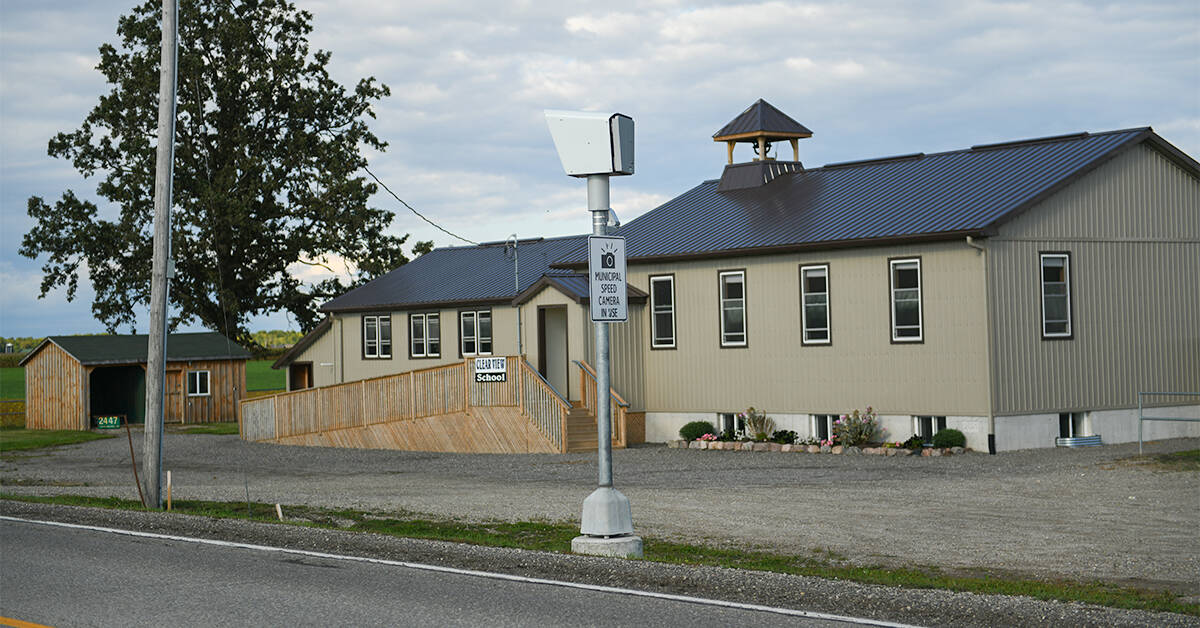The Region of Waterloo is trying out a new pilot program to slow the speed limit in school zones this year, and is fully operating its automated speed enforcement program.
The speed limit will be flexible depending on the time of day, week and month to reflect when kids are in school. It will see some school zone areas reduce speed by 10 to 20 kilometres per hour, and set it at 40 kilometres per hour in others.
Areas already set to 40 kilometres per hour will not be further reduced. The adjusted speed limits will be in effect Monday to Friday, 7 a.m. to 5 p.m. from September to June.
By the end of September, the region will have 16 automated speed enforcement (ASE) sites up and running. These sites feature automatic cameras that take pictures of drivers’ license plates if they are driving over the posted speed limit in school zones. Fines issued are the same as those given out by police, says Bob Henderson, the region’s manager of transportation engineering.
The ASE program was introduced to the region this year.
“Based on our data collection and observations, we’ve seen an overall average reduction in driver speeds,” he said of the difference ASE has made in the region. “We’re anticipating sustained reductions going forward as drivers get more used to speed enforcement in school zones.”
According to the Highway Traffic Act, Automated Speed Enforcement is only permitted in community safety zones and school zones. Henderson says the region municipalities have opted to only allow them in school zones.
Henderson says his department is looking to expand ASE to eight more locations in 2023 and another eight in 2024, pending funding and council approval.
To people who think ASE represents too much surveillance, Henderson has a response.
“We’ve tried a number of avenues to get people to decrease their speed in school zones for the safety of kids, our most vulnerable citizens. We’ve tried police enforcement, we’ve tried other traffic-calming measures, and there continues to be a number of people that feel it’s OK to speed through school zones and other places.
“I get calls and complaints from a number of people, parents of school children, people that live on these streets near schools, there continues to be speeding problems in these areas. Automated speed enforcement has been the most effective piece of technology, or the most effective countermeasure and reducing speed of drivers in these areas. So, this initiative is simply all about safety.”
To illustrate that speeding is still a problem in school zones, Henderson shared a data set from Katherine Street in Winterbourne near Foundation Christian School with a posted speed limit of 50 km/hour from Tuesday, May 14, 2019.
Throughout the day, 457 vehicles travelled 60 km per hour and over. This included one vehicle travelling over 120 km/h per hour at 8:30 that morning.
Another example from Thursday May 14, 2015 on Westmount Road near Laurentian Public School with a 50 km per hour posted speed limit showed 2,867 vehicles traveling 60 km per hour and over throughout the day.
According to a May report to the regional planning and works committee from the transportation and environmental services department, the automated speed enforcement program has reduced speed between two and 15 per cent depending on location, with an overall average in speed reduction of nine per cent, or 5 km/h.
“Rural school zones have in general seen more speed reductions,” the report stated.
Paula Pizarro is the principal of St. Teresa of Avila Catholic Elementary School, located on First Street in Elmira.
“The safety, security and wellbeing of our students, staff and visitors is always our top priority, and so we are always concerned about speeding, distracted driving (people on cell phones, etc.) and even incidences of road rage near schools, and any efforts to reduce both are certainly welcome,” she said to The Observer via email.
When asked if speeding near her school is a problem, she said, “I have observed most drivers respect the posted speed limit,” and that, “I have not been approached by staff or parents regarding a concern with speeding near our school.”
The net fines collected from the automated speed enforcement program go to the region, says Henderson.
So far in 2022, the ASE program generated $100,000, said Henderson. He said that ASE cost $700,000 to install, and costs $150,000 a year to operate, he said. “So if someone wants to make the argument that this is a cash grab, it’s not, based on those numbers.”
The same May report to the planning and works committee stated that staff anticipate that ASE will generate about $200,000 in net revenue per year.
Henderson said the operating dollars go toward paying the vendor, called Redflex, that operates the machines, and also paying into the operation of a ticket processing centre in Toronto that is jointly paid for by multiple municipalities, where provincial offences officers review and issue the tickets, among other costs.
In this year’s pilot program with the adjusted speed limits during school hours, people will be ticketed in person via police officers. A list of the locations can be found online at the region’s website, www.regionofwaterloo.ca/en/resources/school-zone-speed-limits.pdf.









